Definition: Porter’s value chain or VCA (Value Chain Analysis) refers to the analysis and planning of a series of business activities (primary and secondary). These activities should be executed in such a manner that it adds value or utility to the customer experience from their purchase of products or services.
A known American Economist, Michael Eugene Porter first stated the Value Chain concept in the year 1985, in his book ‘ Competitive Advantage’.
Content: Porter’s Value Chain
What is a Value Chain?
Value chain refers to a set of activities which are carried out systematically, to add utility to the final products or services offered for sale. Value creation is a significant part of all business transactions today.
Porter’s Value Chain Analysis (VCA)
Porter’s value chain analysis is a dynamic management tool which classifies hundreds of business activities into nine major categories.
To understand the idea more cleary, go through the following Porter’s value chain model:
Value Chain Activities
Value chain analysis comprises of nine major activities, out of which there are five primary activities, while four are the support activities. Let us now go through each of these activities in detail below:
Primary Activities
The activities which are carried out for the manufacturing of goods or services are termed as primary activities. These can be categorized as follows:
Inbound Logistics
These processes include the availability of raw material, its warehousing and distribution to the various internal units. To create value, the organization should ensure a healthy supplier relationship.
Operations
The production activities are carried out for transforming the raw material into finished or semi-finished products. Thus, value creation derives from efficient management of the operational systems, here.
Outbound Logistics
The activities which initiate the delivery of final goods or services to the customers are called outbound logistics. It starts right from the warehousing of the products to its transportation and distribution to final customers.
Marketing and Sales
It includes all those activities which contribute to the placing or positioning of the products or services in the consumer market and building strong public relations.
Service
The activities related to customer service creates the highest value for the buyers and therefore, leads to organizational success.
Support or Secondary Activities
Secondary operations or activities back all the primary activities or processes. These support activities include:
Firm Infrastructure
These activities relate to the various administrative, quality assurance, accounting, finance, general management, planning, government regulations and legal operations.
Technology Development
Technological advancement is the key to new product development and product differentiation.
The activities, like placing the right person in the correct position, ensures optimal human resource utilization and value creation.
Procurement
The purchase activities related to acquiring raw material or fixed assets, including vendor selection, price negotiation, etc. are responsible for value creation from such transactions.
Using the Value Chain Analysis Tool
The value chain has been adopted by the organizations to acquire a competitive edge over its business rivals. There are two types of objectives which a company can aim through value chain analysis. These are as follows:
Use of Value Chain Analysis for Cost Advantage
Cost advantage refers to influencing consumers on the grounds of value for money. The process of applying a value chain model for cost advantage are as follows:
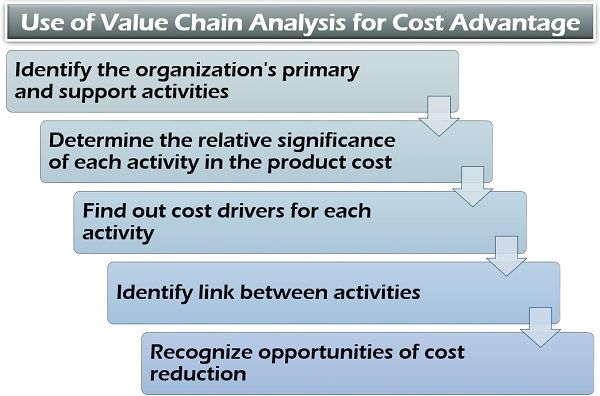
- The manager first needs to analyze all the activities involved in supply chain management individually.
- The cost of each activity or process involved in product manufacturing is ascertained separately through ABC (Activity Based Costing).
- The manager needs to analyze the factors that influence the cost of each activity. It enhances the value of the process, so identified.
- Due to the interrelation between the activities, change in the cost of one process influences the value of other, positively or negatively.
Therefore, the manager has found out such interlinked activities and the relation between their costs. - Finding out the areas of improvement, i.e., the activities which have a scope of cost reduction, to attain efficiency.
Use of Value Chain Analysis for Differentiation Advantage
When the company aims at differentiation advantage over its competitors, it seeks for developing unique product features, customization, better service, gifts, etc.
Given below is the step by step process of adding value for attaining differentiation advantage:
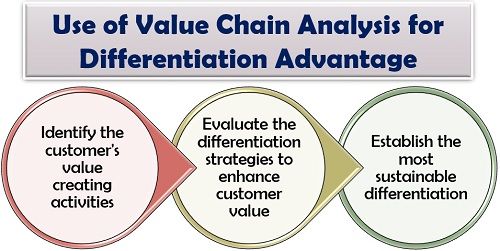
- Understanding what activities generate value for the customers and thus, concentrate on those particular activities.
- Centralizing the value-creating strategies, the manager can adapt the product differentiation activities such as:
- Product customization
- Add on new features
- Complementary product offering
- Improved customer service
- Selecting the most suitable combination of linked activities and strategies to attain sustainable and optimal product differentiation.
Importance of VCA
The value chain analysis is one of the essential functions of all the business entities. Since the fulfilment of utility is not the only requirement of the consumers in today’s competitive era. Instead, every customer looks for value addition.
The business units need value chain analysis because of the following reasons:
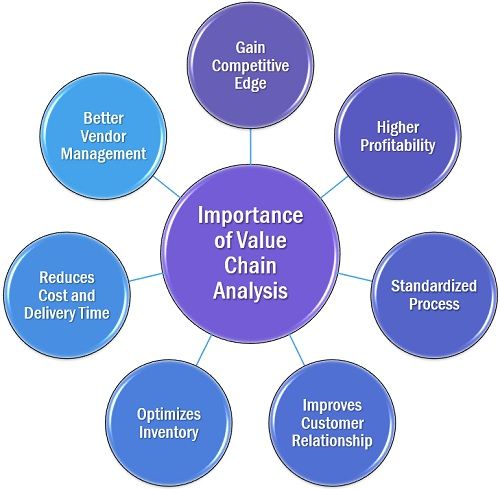
- Gain Competitive Edge: Porter’s value chain model provides an advantage for competitive analysis of cost and differentiation.
- Higher Profitability: When the company reduces the cost of a product or creates product differentiation, it can increase its profit margin and sales.
- Standardized Process: In the process of enhancing the value created at each step, the organization is engaged in setting up superior benchmarks to standardize all its activities.
- Improves Customer Relationship: With better and improved products or services, the organization can strengthen its relationship with its customers and associates.
- Optimizes Inventory: An enhanced supply chain management results into a streamline inventory management, thus ensuring an optimum level of stock.
- Reduces Cost and Delivery Time: By using the VCA for a cost advantage, the organization can attain cost minimization. Also, with a well-managed supply chain, the delivery and transition time can be reduced.
- Better Vendor Management: The value creation in the process of inbound logistics, lead to a higher control over the suppliers.
Limitations of VCA
Porter introduced the business world to the concept of the value chain. It has been broadly implemented by managerial personnel to enhance organizational growth.
But, one cannot overlook the following shortcomings of this concept:
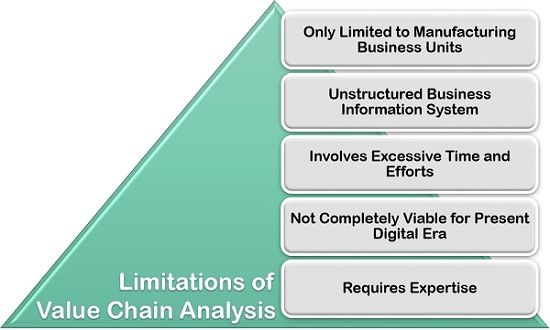
- Only Limited to Manufacturing Business Units: Porter’s value chain model was found suitable only for the manufacturing and production industries and less appropriate for other business organizations.
- Unstructured Business Information System: This type of business information system devoids the availability of complete and simplified information essential for value chain analysis.
- Involves Excessive Time and Efforts: A value chain involves various activities. Therefore, analyzing and planning for each of these activities consumes a lot of time and efforts of the managers.
- Not Completely Viable for Present Digital Era: This concept was introduced way back in 1985 when things were very different from the present-day digital scenario. Thus, the illustrations given by Porter in his book ‘Competitive Advantage’ are not suitable for today’s digital era.
- Requires Expertise: The concept of the value chain is easily coherent by people. But, its application requires a lot of analytical skill and expertise.
Conclusion
We know that SWOT analysis refers to the identification of strengths, weaknesses, opportunities and threats of a business organization.
Whereas, value chain analysis is the examination of all the business activities and processes to determine the organizational strengths and weaknesses intensely.
Therefore, value chain analysis is a broader concept as compared to SWOT analysis.
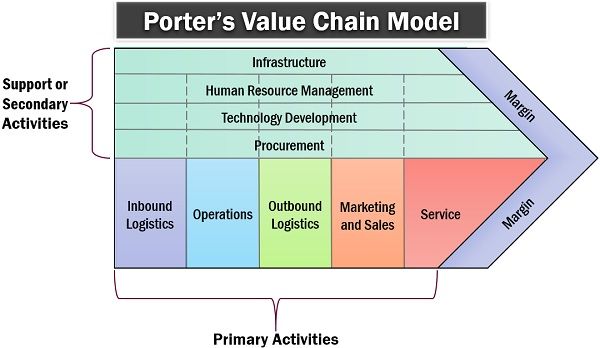
Leave a Reply